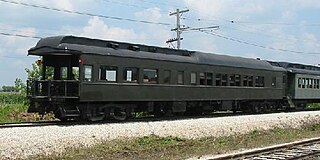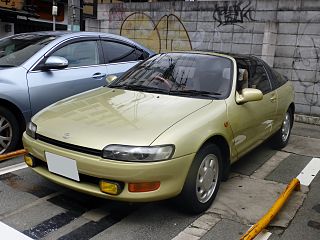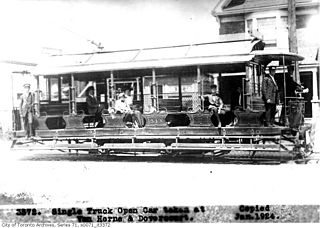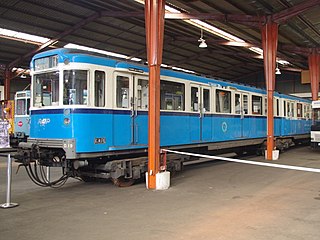
A valve is a device or natural object that regulates, directs or controls the flow of a fluid by opening, closing, or partially obstructing various passageways. Valves are technically fittings, but are usually discussed as a separate category. In an open valve, fluid flows in a direction from higher pressure to lower pressure. The word is derived from the Latin valva, the moving part of a door, in turn from volvere, to turn, roll.

The PCC is a tram design that was first built in the United States in the 1930s. The design proved successful domestically, and after World War II it was licensed for use elsewhere in the world where PCC based cars were made. The PCC car has proved to be a long-lasting icon of streetcar design, and many remain in service around the world.

Coupé de ville — also known as town car or sedanca de ville — is a car body style produced from 1908 to 1939 with an external or open-topped driver's position and an enclosed compartment for passengers. Although the different terms may have once had specific meanings for certain car manufacturers or countries, the terms are often used interchangeably.

The Audi A2 (internally designated Typ 8Z) is a lightweight compact MPV-styled supermini car, with a five-door hatchback body style and four or five seats, produced by the German manufacturer Audi from November 1999 (for the 2000 model year) to August 2005. Based on the Audi Al2 concept car first shown at the Frankfurt Motor Show in 1997, the A2 was notable for being constructed from aluminium, which in combination with its efficient engines, made it an extremely economical car on fuel.
There are many types of car body styles. They vary depending on intended use, market position, location, and the era they were made in.

Touring car and tourer are both terms for open cars. "Touring car" is a style of open car built in the United States which seats four or more people. The style was popular from the early 1900s to the 1930s. The cars used for touring car racing in various series since the 1960s, are unrelated to these early touring cars, despite sharing the same name.

In railroad terminology, a stock car or cattle car is a type of rolling stock used for carrying livestock to market. A traditional stock car resembles a boxcar with louvered instead of solid car sides for the purpose of providing ventilation; stock cars can be single-level for large animals such as cattle or horses, or they can have two or three levels for smaller animals such as sheep, pigs, and poultry. Specialized types of stock cars have been built to haul live fish and shellfish and circus animals such as camels and elephants. Until the 1880s, when the Mather Stock Car Company and others introduced "more humane" stock cars, death rates could be quite high as the animals were hauled over long distances. Improved technology and faster shipping times have greatly reduced deaths.

A sunroof is a movable panel that opens to uncover a window in an automobile roof, allowing light and fresh air to enter the passenger compartment. Sunroofs can be manually operated or motor driven, and are available in many shapes, sizes and styles. While the term "sunroof" is now used generically to describe any glass panel in the roof, the term "moonroof" was historically used to describe stationary glass panes rigidly mounted in the roof panel over the passenger compartment. A moonroof has a glass panel that is transparent and usually tinted. Previous terms include Sunshine Roof, Sliding Head and Sliding Roof.

An observation car/carriage/coach is a type of railroad passenger car, generally operated in a passenger train as the rearmost carriage, with windows or a platform on the rear of the car for passengers' viewing pleasure. The cars were nearly universally removed from service on American railroads beginning in the 1950s as a cost-cutting measure in order to eliminate the need to "turn" the trains when operating out of stub-end terminals.

The Toyota Sera is a 3-door 2+2 hatchback coupe manufactured and marketed by Toyota from 1990 to 1996. It was only officially sold in Japan.

The Toronto Railway Company (TRC) was the operator of the streetcar system in Toronto between 1891 and 1921. It electrified the horsecar system it inherited from the Toronto Street Railway, the previous operator of streetcar service in Toronto. The TRC was also a manufacturer of streetcars and rail work vehicles, a few of which were built for other streetcar and radial operators.

The AB Standard was a New York City Subway car class built by the American Car and Foundry Company and Pressed Steel Car Company between 1914 and 1924. It ran under the operation of the Brooklyn Rapid Transit Company (BRT) and its successors, which included the Brooklyn–Manhattan Transit Corporation (BMT), the New York City Board of Transportation, and the New York City Transit Authority (NYCTA). The cars were designed following the signing of the Dual Contracts, which called for a major expansion of the BRT. A total of 950 cars were built.

The Citroën Type C was a light car made by the French Citroën car company between 1922 and 1926 with almost 81,000 units being made. Known as Citroën 5HP or 5CV in France and 7.5HP in Britain, it was the second model of automobile designed and marketed by André Citroën, between 1922 and 1926. It followed the 10HP "Type A " (1919), then 10HP "B2" (1921); they were the first European mass-produced cars.

The Ford Thames 400E is a commercial vehicle that was made by Ford UK and introduced in 1957. Production of the range continued until September 1965, by which time a total of 187,000 had been built. Publicity for the model included hiring the Cy Laurie band to make the promotional film short 'Band Wagon', in 1958, preserved in the 'Ford Film and Video Collection' at the National Motor Museum, Beaulieu

The Matériel Articulé (MA), also known as the MA 51, was a type of rolling stock on the Paris Métro and was in service between 1951 and 1994.

Car controls are the components in automobiles and other powered road vehicles, such as trucks and buses, used for driving and parking.
In 1900, Chicago already had the second largest cable car network in the United States and would eventually surpass New York City to have the largest streetcar network in the world in a few decades. In 1900, there were three private companies operating 41 miles (66.0 km) of double track routes radiating out from Chicago's downtown area. State of the art technology when the first line opened in 1882, by 1900 electric traction had proven superior and in 1906 all cable routes were changed to electrical power. Decades later, most were part of Chicago Transit Authority bus routes.

The Boynton Bicycle Railroad was a monorail in Brooklyn on Long Island, New York. It ran on a single load-bearing rail at ground level, but with a wooden overhead stabilising rail engaged by a pair of horizontally opposed wheels. The railway operated for only two years, but the design was adopted elsewhere.

The Honda N-Van is a microvan produced by Honda for the Japanese market. The origin for the vehicle's name expresses "next generation light van" proposed by N series as see in the N-One, N-Box, and N-WGN: it is part of a renewed lineup of Kei class city cars. The use of the letter "N" in the name was used by Honda for the late 1960s and 1970s Honda N360.


















